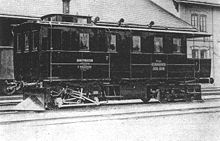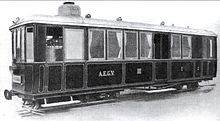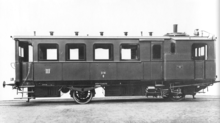Steam railcar


Asteam railcar,steam motor car(US), orRailmotor(UK) is arailcarthat is self powered by asteam engine.The first steam railcar was an experimental unit designed and built in 1847 byJames SamuelandWilliam Bridges Adamsin Britain. In 1848 they made theFairfield steam carriagethat they sold to theBristol & Exeter Railway,who used it for two years on a branch line.
Origins
[edit]The first steam railcar was designed byJames Samuel,theEastern Counties RailwayLocomotive Engineer, built byWilliam Bridges Adamsin 1847, and trialled between Shoreditch and Cambridge on 23 October 1847. An experimental unit, 12 feet 6 inches (3.81 m) long with a small vertical boiler and passenger accommodation was a bench seat around a box at the back.[1]The following year Samuel and Adams built theFairfield steam carriage.This was much larger, 31 feet 6 inches (9.60 m) long, and built with an open third class section and a closed second class section. After trials in 1848, it was sold to theBristol and Exeter Railwayand ran for two years on theTiverton branch.[2]
History by country
[edit]Argentina
[edit]In 1905, theBuenos Aires Great Southern Railwaypurchased a steam railcar fromKerr, Stuart and Company.[3][4]Birmingham Railway Carriage and Wagon Companysupplied atwin-carunit with an oil-fired boiler in 1931 to theEntre Ríos Railway.[5]
Australia
[edit]
In 1883, theVictorian Railwayspurchased theRowan steam railmotor.[6]Two double-decker units were imported fromBelgiumby theSouth Australian Railwaysin 1895.[7]

In 1913,Kerr, Stuart and Companybuilt a boiler, shipped it to Australia and theVictorian Railwaysassembled theKerr Stuart steam railmotor.[7]
Austria–Hungary
[edit]This sectionneeds expansion.You can help byadding to it.(October 2012) |

In 1880, Ringhoffer ofPraguebuilt a steam railcar for theÖsterreichische Lokaleisenbahngesellschaft(Austrian local railway). With 32 seats and a maximum speed of 18 kilometres per hour (11 mph), it had been withdrawn by 1900. In the early 20th century, theImperial Royal Austrian State Railwaysordered a railcar with a Serpollet boiler fromEsslingen,followed by a number of cars with boilers from Komarek ofViennaand carriages from Ringhoffer. TheNiederösterreichische Landesbahnen(Lower Austrian State Railway) also bought cars made by Komarek and Rohrbacher. Most cars had been withdrawn by the end of World War I, and those that remained whenAustria-Hungarywas divided in 1918 were divided between theCzechoslovak State Railwaysand theAustrian Federal Railways.All units having been withdrawn by the end of the 1950s, as of 2012[update]one car is preserved operational at theCzech Railway MuseuminLužná (Rakovník District).[8]

Between 1901 and 1908,Ganz Worksof Budapest and de Dion-Bouton of Paris collaborated to build a number of railcars for the Hungarian State Railways together with units with de Dion-Bouton boilers, Ganz steam motors and equipments, and Raba carriages built by the Raba Hungarian Wagon and Machine Factory in Győr. In 1908, the Borzsavölgyi Gazdasági Vasút (BGV), a narrow-gauge railway inCarpathian Ruthenia(today's Ukraine), purchased five railcars from Ganz and four railcars from the Hungarian Royal State Railway Machine Factory with de Dion-Bouton boilers. The Ganz company started to export steam motor railcars to the United Kingdom, Italy, Canada, Japan, Russia and Bulgaria.[9][10][11]
Brazil
[edit]In 1928, theLeopoldina Railway(de)purchased a steam railcar for inspection services bySentinel Waggon Works.[12][13]
Britain
[edit]Steam railcars to be built in Britain in the early 20th century for theLondon and South Western Railway(L&SWR) and before entering passenger service one was lent to theGreat Western Railway(GWR) for a trial run in the Stroud Valley between Chalford and Stonehouse in Gloucestershire.[14]Between 1902 and 1911, 197 steam railcars were built, 99 by the GWR.[15]
Introduced either due to competition from the new electric tramways or to provide an economic service on lightly used country branch lines, there were two main designs, either a powered bogie enclosed in a rigid body or an articulated engine unit and carriage, pivoting on a pin. However, with little reserve power steam railcars were inflexible and the ride quality was poor due to excessive vibration and oscillation. Most were replaced by anautotrain,adapted carriages and a push-pull steam locomotive as these were able to haul additional carriages or goods wagons.
After trials in 1924, theLondon and North Eastern Railwaypurchased three types of steam railcars from Sentinel-Cammell and Claytons.
Egypt
[edit]
Experiments with a steam railcar in 1926 led to the acquisition of many examples of this type of vehicle by theEgyptian State Railways.Clayton Wagonssupplied sixtwin-carunits in 1928.[42]Birmingham Railway Carriage and Wagon Company13 similar vehicles in 1930.[43]Sentinel and Metro-Cammell supplied ten twin-car units in 1934.[44]
In 1951, Sentinel and Metro-Cammell built ten 3-car steam railcar units for theEgyptian National Railways.The units were articulated, with an oil-fired boiler supplying steam to two 6-cylindersteam motors.Withdrawn from service in 1962, as of 2012[update]one unit is under restoration at theBuckinghamshire Railway Centre.[44]
France
[edit]
At the beginning of the 20th centurySociété Valentin Purreypatented a steam engine that was used in railcars. Built in Bordeaux by 1903 fifty cars had been built, including 40 to theCompagnie Générale des Omnibus-Paris.[45]Also,Buffaud & Robatelbuilt a steam railcar for the metre gaugeChemin de fer de Kayes au NigerinMali.[46]
Germany
[edit]This sectionneeds expansion.You can help byadding to it.(October 2012) |

In 1879, Georg Thomas of theHessian Ludwig Railwaydeveloped a double-decker steam railcar, for which he was granted a patent in 1881. The three-axle vehicle consisted of a single-axle engine unit and a two-axle double-deck carriage part, rigidly coupled together and separable only in the workshop. The Hessian Ludwig Railway built three in 1879–80, followed by theRoyal Saxon State Railways,the Oels-Gniezno Railway and theRoyal Württemberg State Railways.TheRoyal Bavarian State Railwaysbuilt a similarBavarian MCiin 1882. All had been withdrawn in the early 20th century.
In 1895, theRoyal Württemberg State Railwaysordered a steam railcar using a Serpollet boiler fromEsslingen,followed by six more. At first, their performance was unsatisfactory, until Eugen Kittel of the Württemberg State Railways developed a new firebox. Seventeen were built for the Württemberg State Railways and railcars were also made for theRoyal Saxon State Railways,Swiss Northeastern RailwayandImperial Royal Austrian State Railways,and theGrand Duchy of Baden State Railwayin 1914–15.

In 1918, the Austrian State Railways unit passed to theCzechoslovak State Railwaysafter Austria-Hungary was divided at the end ofWorld War I.At the end ofWorld War IIunits were divided between theDeutsche Reichsbahnof East Germany,Deutsche Bundesbahnof West Germany andSNCFof France and all units had been withdrawn by 1953.
In 1906, thePrussian state railwaysbought two steam railcars, one fired by coal and the other oil, fromHannoversche Maschinenbau AG.
SevenBavarian MCCiunits were built between 1906 and 1908 for the Royal Bavarian State Railways for suburban services in the Munich area, the coach bodies being manufactured byMANand the engines byMaffei.These had all been withdrawn by the end of the 1920s.
A steam railcar, DR 59, was built byWismarin 1937 to reduce the dependency on imported diesel or petrol. After the war ownership of the car passed to theDeutsche Reichsbahnof East Germany, and in 1959 was converted into a driving trailer and withdrawn in 1975.
India
[edit]
TheGreat Indian Peninsula Railwaybought one steam railcar in 1906 fromKerr, Stuart and Company.[47][48]In 1906, theNorth Western State Railwaypurchased a steam motor coach fromVulcan Foundry[49]and in 1907 theEast Indian Railwaybought five steam railcars fromNasmyth, Wilson and Company.[50]In 1925, Sentinel and Metro-Cammell built five twin-car units for theBengal Nagpur Railway.[51][52]
Italy
[edit]
In 1904, two steam railcars were ordered from Purrey; classified as FS 80 these were withdrawn in 1913.[45]Sixty-five railcars, classified as FS 60, were purchased in 1905 to 1907, but found to be under-powered and sixteen were converted into locomotives.[53]At the 1906Milan FairanFS 85(it)was exhibited and three were purchased byKerr, Stuart and Company,followed by 12 also British builtFS 86(it).[54]
In 1938, three railcars using high-pressure steam were purchased and classifiedALv 72(it).These were sold toFerrovie Padanein 1940 and converted into passenger coaches.[55]
Japan
[edit]
TheJapanese Government Railwayshad several steam railcars in their employ before experimenting with petrol and diesel cars.[56]
Mali
[edit]
French manufacturersBuffaud & Robatelbuilt a steam railcar for the metre gaugeChemin de fer de Kayes au NigerinMali.[46]
Mauritius
[edit]In 1907, theMauritius Government Railwayspurchased a steam railcar fromKerr, Stuart and Company.[57][58]
Namibia
[edit]
In 1907, theOtavi Mining and Railway CompanyinGerman South West Africa(today'sNamibia) purchased two steam railcars built byMAN SEin cooperation withMaffeifor600 mm gauge.[59]
New Zealand
[edit]In 1925 and 1926, two steam railcars were supplied toNew Zealand Railways Department,one from Sentinel and Cammell and the other from Claytons.[60]They were both withdrawn after a few years.[61][62]
Nigeria
[edit]TheNigerian Railwayspurchased several 3-car steam railcar units in 1954 fromMetro-Cammell.The units were articulated, with an oil-fired boiler supplying steam.[63]
North America
[edit]In North America, a railcar is known as aDoodlebugand the steam railcar as a steam motor car. TheNew England Railroadpurchased a steam motor car bySchenectady Locomotive Worksin 1897.[64]In 1906, theCanadian Pacific Railwayhad an oil fired steam railcar[65]and in 1908 theChicago, Rock Island and Pacific Railroadpurchased one byAlco-Schenectady.[66]

In 1911, theAtchison, Topeka and Santa Fe Railwaybuilt a steam-powered railcar combining a Jacobs-Schupert boiler and aGanz Workspower truck in anAmerican Car and Foundrybody. The resulting doodlebug was designated M-104. It operated experimentally under its own power for only three months. With the steam machinery removed and an unpowered bogie truck substituted, the car operated as an unpowered combine (combination baggage-coach car) until the 1960s.[67]
The steam motor cars in North America reached their popular apex before the 1880s, with most fabricated to custom designs by small specialty builders before 1875. nearly all examples were unique and purpose-built to order; a few were experimental cars built and marketed by small firms or individuals on a trial basis and often not entirely successful due to their uniqueness or relative costs. The rise of electric traction was one cause for the ultimate demise of American steam motor cars.[68]
Portugal
[edit]
In 1906, thePortuguese Railway Companypurchased two steam railcars fromBorsig.[69]
South Africa
[edit]There were a total of three steam railcars in South Africa, all imported from Britain and all running on theCape gaugeof 1,067 mm common there.
Sudan
[edit]TheSudan Government Railwaysbought two steam railcars fromClayton Wagonsin 1929.[70]
Sweden
[edit]
Steam railcars were used in Sweden in the 1880s.[citation needed]
Switzerland
[edit]
In 1889, steam railcars were built for thePilatus Railway,a rack railway in Switzerland with a maximum gradient of 48%.
Cars Nos. 1-9 were built by theSwiss Locomotive and Machine WorksinWinterthur,followed by No. 10 in 1900 and no. 11 in 1909. The railway was electrified in 1937, and the cars scrapped except for two. Car no. 9 remained until 1981 as a reserve and has since been in theSwiss Transport Museumin Lucerne. Car no. 10 is on permanent loan to theDeutsches Museumin Munich.[71][72]
In 1902, a steam railcar was built byMaschinenfabrik Esslingen.Not a success, it was rebuilt in 1907 and sold to theUerikon Bauma Railway.The railcar was withdrawn in 1950 and as of 2012[update]the railcar is restored.[73]
Trinidad and Tobago
[edit]TheTrinidad Government Railwaypurchased two steam railcars secondhand from theLondon, Brighton and South Coast Railwayin 1921, but they have never been put in operation.[74] One of the coach parts was converted into the Governor's saloon and the other into a second class carriage. In 1931, a Sentinel-Cammell twin articulated steam railcar was acquired.[75]
Notes and references
[edit]References
[edit]- ^Rush 1971,p. 16.
- ^abRush 1971,pp. 16–18.
- ^"Rail Motor Coaches".The Railway Magazine(98): 136. August 1905.
- ^"Los coches motor a vapor del Ferrocarril Sud"(in Spanish). 13 May 2020.Retrieved22 July2022.
- ^Ostendorf 1977,pp. 153–154.
- ^Vincent, Peter J. (20 October 2007)."Rowan Steam Car / ABDL".Retrieved15 May2022.
- ^abOstendorf 1977,pp. 170–176.
- ^"Steam railcar M 124.001".cdmuszeum.cz.Retrieved8 October2012.
- ^Railroad Gazette – Volume 37 – Page 296 (printed in 1904)
- ^Modern Machinery – Volumes 19-20 – Page 206 (Printed in 1906)
- ^John Robertson Dunlap,Arthur Van Vlissingen,John Michael Carmody:Factory and Industrial Management – Volume 33 – Page 1003 (printed in 1907)
- ^Brazilian railroads(in Portuguese). Memória do Trem. 2008. p. 34.ISBN9788586094095.
- ^Ostendorf 1977,pp. 180–181.
- ^"First trail in Gloucestershire – Great Western Railway History".Retrieved30 January2013.
- ^Jenkinson 1996,p. 257.
- ^Rush 1971,pp. 22–24.
- ^Rush 1971,p. 39.
- ^Rush 1971,p. 47.
- ^Rush 1971,pp. 81–83.
- ^abcdRush 1971,pp. 65–66.
- ^Hedges 1980,p. 136.
- ^Rush 1971,pp. 93–94.
- ^Rush 1971,p. 30.
- ^Rush 1971,p. 51.
- ^abMountford, Eric. R. (1987).The Barry Railway; Diagrams and Photographs of Locomotives, Coaches and Wagons.The Oakwood Press. p. 21,35.ISBN0-85361-355-9.
- ^abRush 1971,pp. 72–73.
- ^Rush 1971,pp. 70–71.
- ^Rush 1971,pp. 95–97.
- ^Rush 1971,p. 63.
- ^Rush 1971,pp. 58–59.
- ^Rush 1971,pp. 76–77.
- ^abRush 1971,p. 89.
- ^Rush 1971,pp. 88–89.
- ^Rush 1971,pp. 84–85.
- ^abRush 1971,p. 90.
- ^abRush 1971,p. 32.
- ^abRush 1971,p. 33.
- ^Rush 1971,pp. 119, 123–125.
- ^Rush 1971,p. 123.
- ^abRush 1971,p. 124.
- ^Rush 1971,pp. 121–122.
- ^"Articulated steam rail coach for Egypt".Grace's Guide To British Industrial History.Retrieved14 March2022.
- ^"Articulated steam rail coach for Egypt".Grace's Guide To British Industrial History.Retrieved4 March2022.
- ^ab"Sentinel-Cammell Steam Railcar No. 5208".BRC Stockbook.9 October 2009.Retrieved4 March2022.
- ^abCruciani, Marcello (May 1999). "Purrey in Italia".I Treni(in Italian) (204): 17–21.
- ^ab"Voiture automotrice à vapeur" [Steam self-propelled car].Moniteur Industriel:111. 13 February 1909.
- ^"Kerr, Stuart and Co".Grace's Guide To British Industrial History.Retrieved12 March2022.
- ^"New Locomotives for the Great Indian Peninsula Ry".The Locomotive Magazine.Vol. XII, no. 125. 14 July 1906. p. 114.
- ^"Steam motor coach, N.W.R., India".Grace's Guide To British Industrial History.Retrieved24 May2022.
- ^"Steam Railway Motor Coach – East Indian Railway".Grace's Guide To British Industrial History.Retrieved12 March2022.
- ^Ostendorf 1977,pp. 159–160.
- ^"Bengal Nagpur, Articulated Sentinel-Cammell steam railcar, mid 1920's".Flickr.27 June 2017.Retrieved24 May2022.
- ^Briano, Italo (1977).Storia delle ferrovie in Italia(in Italian). Vol. III. pp. 65–68.OCLC490069757.
- ^Bruno Bonazzelli:L'album delle locomotive(seconda parte)
- ^"Automotrici a vapore ALv 72".Retrieved14 May2022.
- ^Ostendorf 1977,pp. 160–164.
- ^Ostendorf 1977,p. 139.
- ^"Steam rail motor coaches".Locomotive, Railway Carriage & Wagon Review.Locomotive Publishing Company. 1907. p. 206.
- ^Ostendorf 1977,p. 137.
- ^"Railway steam car for New Zealand".Grace's Guide To British Industrial History.Retrieved14 March2022.
- ^Bromby, Robin (2003).Rails that built a Nation: An Encyclopaedia of New Zealand Railways.Wellington: Grantham House. p. 123.ISBN1-86934-080-9.
- ^Leitch, David; Scott, Brian (1995).Exploring New Zealand's Ghost Railways(1998 ed.). Wellington: Grantham House. p. 78.ISBN1-86934-048-5.
- ^Ostendorf 1977,pp. 133–134.
- ^"The" Composite "Car".Locomotive Engineering:817–818. November 1897.
- ^"Steam Motor Car for the Canadian Pacific Railway".Railway Age:254–255. August 1906.
- ^"Steam Motor Car for the Rock Island".Railway Age:961–964. September 1908.
- ^Worley, E.D. (1965).Iron Horses of the Santa Fe Trail.US: Southwest Railroad Historical Society.
- ^Alden P. Armagnac (December 1937)."Steam Still Rules The Rails".Popular Mechanics:32–33, 131–132.
- ^Ostendorf 1977,p. 124.
- ^Ostendorf 1977,p. 138.
- ^Buckley, R. J.; Wyse, W. J. (1984).Tramways and Light Railways of Switzerland and Austria.Light Rail Transit Association.ISBN978-0-900433-96-2.
- ^Chronik der Eisenbahn(in German). Heel Verlag GmbH. 20 December 2005.ISBN978-3-89880-413-4.
- ^Moser, Alfred; Winter, Paul (1975).Der Dampfbetrieb der schweizerischen Eisenbahnen, 1847–1966(in German). Birkhäuser.ISBN3-7643-0742-0.
- ^"The Trinidad Government Railway - Rolling Stock and Locomotives".Commerce Reports.IV(49). Washington, D.C.: 638 3 December 1923.Retrieved19 September2022.
- ^"Locomotives of the Trinidad Government Rlys".Locomotive Magazine and Railway Carriage and Wagon Review.42(522): 53–55. 15 February 1936.
Sources and further reading
[edit]- Britain
- Hedges, Martin, ed. (1980).150 Years of British Railways.Hamlyn.ISBN0-600-37655-9.
- Jenkinson, David (1996).History of British Railway Carriages, 1900–53.Atlantic Transport.ISBN978-1899816033.
- Rush, R.W (1971).British Steam Railcars.Oakwood Press.ISBN0-85361-144-0.
- Tufnell, R.M. (1984).The British Railcar: AEC to HST.David and Charles.ISBN0-7153-8529-1.
- Austria-Hungary
The following books are in German
- Adolph Giesl-Gieslingen (1981).Aera nach Golsdorf: Die letzten drei jahrzehnte des osterreichischen Dampflokomotivhaus.Slezak.ISBN978-3-900134-37-2.
- Alfred Horn; Wilhelm Urbanczik (1972).Dampftriebwagen und Gepäcklokomotiven in Österreich, Ungarn, der Tschechoslowakei und Jugoslawien.Bohmann.ISBN978-3-7002-0309-4.
- Dieter Bäzold, Rolf Löttgers, Günther Scheingraber u. a.: Preußen-Report, Band 9: Zahnrad- und Schmalspurlokomotiven, Triebwagen. Eisenbahn-Journal, Hermann Merker Verlag, Fürstenfeldbruck 1996 Modelleisenbahner Nr. 4: Preußische Dampftriebwagen der Bauart Stoltz, April 1988, S. 17–20
- Dieter Zoubek (2004).Erhaltene Dampflokomotiven in und aus Österreich 2004.Zoubek, Dieter.ISBN978-3-200-00174-9.
- Helmut Griebel; Josef Otto Slezak; Hans Sternhardt (1 December 1985).BBÖ Lokomotiv-Chronik 1923–1938.Slezak.ISBN978-3-85416-026-7.
- Johann Blieberger; Josef Pospichal (2011).Enzyklopädie der kkStB-Triebfahrzeuge, Band 4: Die Reihen 83 bis 100, Schmalspur- und nicht mit Dampf betriebene Bauarten.bahnmedien.at.ISBN978-3-9502648-8-3.
- Friedrich Slezak; Josef Otto Slezak (1981).Vom Schiffskanal zur Eisenbahn: Wiener Neustädter kanal and Aspangbahn.Verlag Josef Otto Slezak.ISBN978-3-900134-72-3.
- Verzeichnis der Lokomotiven, Tender, Wasserwagen und Triebwagen der k. k. österreichischen Staatsbahnen und der vom Staate betriebenen Privatbahnen nach dem Stande vom 30. Juni 1917, 14. Auflage, Verlag der k. k. österreichischen Staatsbahnen, Wien, 1918
The following books are in Czech
- Karel Beneš (1995).Železnice na Podkarpatské Rusi.Nakl. dopravy a turistiky.ISBN978-80-85884-32-6.
- Karel Just (2001).Parní lokomotivy na úzkorozchodných tratích ČSD.Vydavatelství dopravní literatury Luděk Čada.ISBN978-80-902706-5-7.
The following books are in Hungarian
- Ernő Lányi (1984).Nagyvasúti vontatójárművek Magyarországon.Közlekedési Dokumentációs Vállalat.ISBN978-963-552-161-6.
- Villányi György (1996).Gőzmotorkocsik és kismozdonyok.Magyar Államvasutak Rt.
- Germany
These sources are in German
- Peter Henkel (1985). "Der Dampftriebwagen nach Thomas".Die Bahn und Ihre Geschichte = Schriftenreihe des Landkreises Darmstadt-Dieburg 2.Darmstadt: Georg Wittenberger / Förderkreis Museen und Denkmalpflege Darmstadt-Dieburg).
- Deutsche Reichsbahn(1935).Hundert Jahre deutsche Eisenbahnen. Jubiläumsschrift zum hundertjährigen Bestehen der deutschen Eisenbahnen.
- Lutz Uebel; Wolfgang Richter (1994).MAN – 150 Jahre Schienenfahrzeuge aus Nürnberg.
- Peter Zander (1989). "Doppelstöckige Dampftriebwagen der Bauart Thomas".Modell Eisenbahner. Eisenbahn-Modellbahn-Zeitschrift.
- Hermann Lohr (1988).Lokomotiv Archiv Württemberg.Transpress.ISBN978-3-344-00222-0.
- Hermann Lohr (1988).Lokomotiv Archiv Baden.Transpress.ISBN978-3-344-00210-7.
- Wolfgang Valtin (1992).Verzeichnis aller Lokomotiven und Triebwagen: Dampflokomotiven und Dampftriebwagen.Transpress.ISBN978-3-344-70740-8.
- Werner Willhaus (September 2008).Kittel-Dampftriebwagen: Innovation des Nahverkehrs vor über 100 Jahren.EK-Verlag.ISBN978-3-88255-106-8.
- Rainer Zschech (1993).Dampf- und Verbrennungstriebwagen: Deutsche Reichsbahn-Gesellschaft, Deutsche Reichsbahn, Deutsche Bundesbahn.Transpress.ISBN978-3-344-70766-8.
- Erich Preuß; Reiner Preuß (1991).Sächsische Staatseisenbahnen.Transpress.ISBN978-3-344-70700-2.
- Fritz Näbrich, Günter Meyer, Reiner Preuß: Lokomotivarchiv Sachsen 2, Transpress VEB Verlag für Verkehrswesen, Berlin, 1983
- Krauss-Maffei,Deutsches MuseumMunich (ca. 1977):Lokomotiven im Deutschen Museum
- Other countries
These sources are in German
- Ostendorf, Rolf (1977).Dampftriebwagen, Bauarten, Typen und Systeme.Motorbuchverlag, Stuttgart.ISBN3-87943-517-0.





